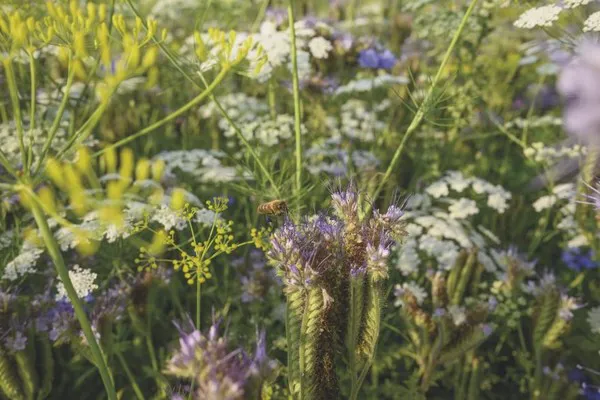Behind the organic greenhouses at Bejo Warmenhuizen, on a small patch of 3240m2, some stunning strips of flowering crops shaped the landscape last summer. This gorgeous pilot trial aimed at investigating the potential of diversified cropping systems and banker plants on the dynamics of pests and their natural enemies of seed crops.
The trial was composed of flower strips at the edges and onion, celery, and fennel in alternating orders, with three-meter strips at the outside and six-meter strips on the inside of the field. Each alternation was separated by another three-meter strip of the flower mixture.

Pests harming the seeds
Especially two genera of pests play a major role in seed production, namely Orthops and Lygus, two members of the Miridae family. Unfortunately for Bejo, their favorite snacks are the embryos of seeds. Their specialized mouthparts allow them to pierce the young seed and subsequently suck out its most nutritious contents, leaving behind inviable seeds without embryos. In addition, the piercing of plant tissues can transmit harmful viruses and diseases. Furthermore, Orthops and Lygus fancy umbelliferous crops (Apiacea, such as carrot, celery, or fennel) but can thrive just fine on any crop.
Natural enemies
The appealing flower strips shall act as a sort of reservoir, or bank, for the natural enemies of these plant bugs, due to the availability of alternative food sources such as pollen and nectar. The natural enemies of these bugs are mostly generalist predators, such as spiders, big-eyed bugs, damsel bugs, lacewings, and harvestmen. However, some specialized predators, like parasitoid wasps, do exist, but so far have not been very abundant. Simultaneously, the flowering strips aim to trap the bugs away from the main crops by being attractive themselves, as several flowering umbellifers were included in the flower mix.
Easing pest pressure
Moreover, seed crops usually finish a bit later than crops grown for the fresh market. As the harvest is a very disturbing action, many insect pests will flee from the fields towards the surroundings, where eventually, the crops grown for seed production are still prospering. This sudden influx of insects creates a strong pest pressure, which we hope to ease out by trapping them in the bordering flower strips.
Bejo found that the most abundant pests are Orthops bugs in the fennel, which also seem to flourish in the flower and celery strips, but to a lesser extent. In onions, the most common pest appeared to be thrips. In regard to their predators, no clear patterns are visible just yet, and more net sweepings will be necessary to further define what is truly going on. Bejo plants, therefore, to continue these flowering trip trials in the coming years.
For more information: Bejo
Bejo
www.bejo.com
